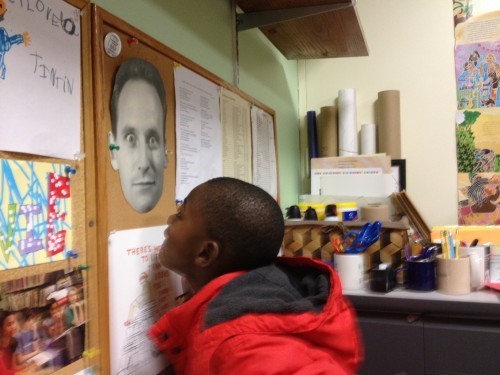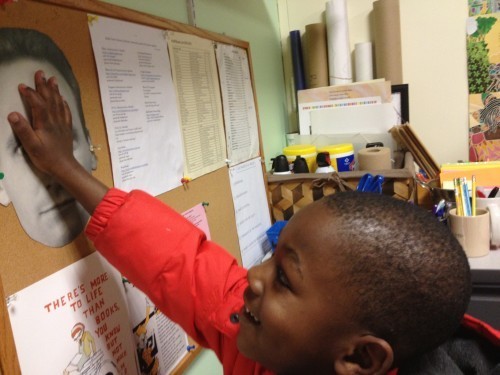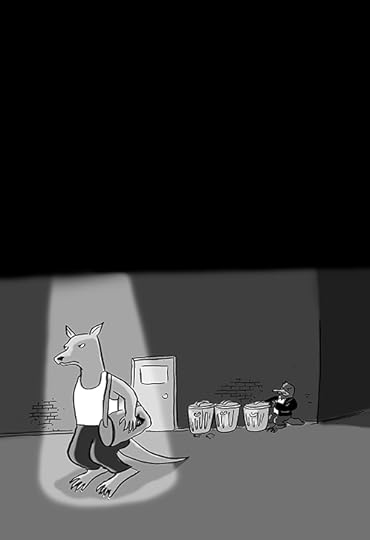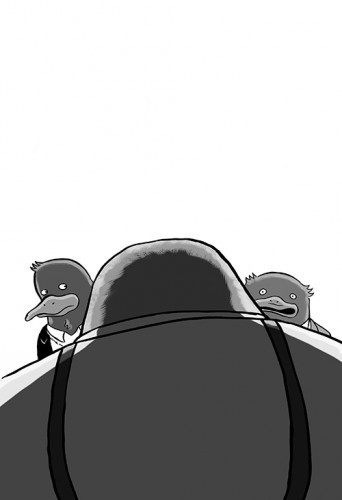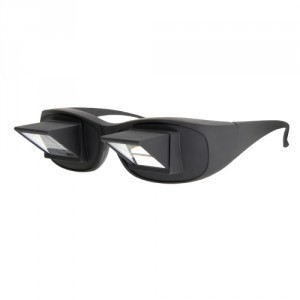Betsy Bird's Blog, page 316
April 4, 2013
Barcelona Bound: Part II
Contrary to appearances I am not accustomed to international travel. I have no frequent flyer miles set up. I wouldn’t know what to do with myself if someone asked me to convert a Euro. Yet in spite of all this, I seem to be on a plane today bound for bright and sunny Spain. Some of you may recall how, two years ago, I combined my trip to the Bologna Book Fair with an additional trip to Barcelona. Well now family reasons compel me to return, this time with a 2-year-old in tow.
How does one prepare one’s offspring for flight and foreign countries? Well, if you’re me, you go to the books.
Step One: Get child comfortable with the notion of flight.
Not too difficult since she flew to the Midwest last Christmastime, but flights overseas are longer, duller, and more confining. Best to make the whole process familiar in some way. So! On to the airport books. The kiddo likes these the most right now:
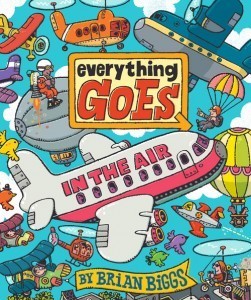 Everything Goes: In the Air by Brian Biggs – Her #1 favorite, no question. The love of Biggs runs strong in the sprog. Whether it’s his illustrations on Cynthia Rylant’s “Brownie and Pearl” series or the work he’s done here (whether the books or the board books), Biggs knows how to give vehicles of every stripe and flavor their due. In In the Air Biggs walks you through the airline process. My kiddo, naturally, is most intoxicated by the shuttle bus at the beginning and the missing babies you’re encouraged to locate throughout the rest of the story. Still, she understands a lot of the airline process thanks to Mr. Biggs and also thanks to . . .
Everything Goes: In the Air by Brian Biggs – Her #1 favorite, no question. The love of Biggs runs strong in the sprog. Whether it’s his illustrations on Cynthia Rylant’s “Brownie and Pearl” series or the work he’s done here (whether the books or the board books), Biggs knows how to give vehicles of every stripe and flavor their due. In In the Air Biggs walks you through the airline process. My kiddo, naturally, is most intoxicated by the shuttle bus at the beginning and the missing babies you’re encouraged to locate throughout the rest of the story. Still, she understands a lot of the airline process thanks to Mr. Biggs and also thanks to . . .
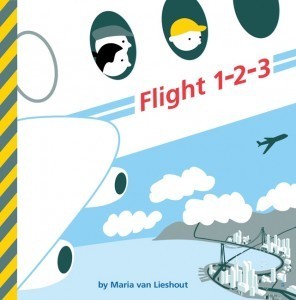 Flight 1, 2, 3 by Maria van Lieshout – This book is not only recent (note the 2013 publication date) but it has a unique take. On the outside it might look like it’s just a walk through the airport process using numbers along the way (counting books are very big in the Bird household right now too). On closer inspection, Ms. van Lieshout tips her hat to the airport and in-flight signs that have become universal symbols. In this book she writes, “Without these signs – mostly designed by AIGA artists Seymour Chwast, Roger Cook, and Don Shanosky – we wouldn’t arrive on time or at the right destination.” Didn’t Seymour Chwast write a picture book or two of his own? Small world. In any case, the book is itself is lovely and quite up-to-date when it comes to airport screenings and all that jazz.
Flight 1, 2, 3 by Maria van Lieshout – This book is not only recent (note the 2013 publication date) but it has a unique take. On the outside it might look like it’s just a walk through the airport process using numbers along the way (counting books are very big in the Bird household right now too). On closer inspection, Ms. van Lieshout tips her hat to the airport and in-flight signs that have become universal symbols. In this book she writes, “Without these signs – mostly designed by AIGA artists Seymour Chwast, Roger Cook, and Don Shanosky – we wouldn’t arrive on time or at the right destination.” Didn’t Seymour Chwast write a picture book or two of his own? Small world. In any case, the book is itself is lovely and quite up-to-date when it comes to airport screenings and all that jazz.
 Airport by Byron Barton – Circa 1982, no less. You might think that most older airport books are about as dated as Fly Away Home by Eve Bunting. And to a certain extent you’d be right. Certainly anytime we whip out a Richard Scarry book it’s an exercise in what no longer exists. But the Barton book is super simple and there’s much to be said for that. It’s hard to top Barton, anyway.
Airport by Byron Barton – Circa 1982, no less. You might think that most older airport books are about as dated as Fly Away Home by Eve Bunting. And to a certain extent you’d be right. Certainly anytime we whip out a Richard Scarry book it’s an exercise in what no longer exists. But the Barton book is super simple and there’s much to be said for that. It’s hard to top Barton, anyway.
Step Two: Introduce the concept of Spain.
This is a bit more difficult. Spain makes as much sense to a toddler as the moon. Less, actually, since they can see the moon and if you told them they’d be taking a trip there they’d completely buy it. But Spain? Here is the kiddo’s #1 association with that country.
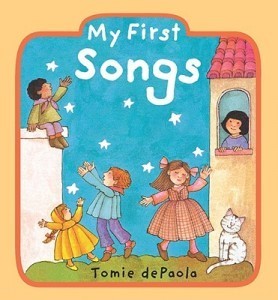 My First Songs by Tomie dePaola – Specifically “Rain Rain, Go Away”. If you’ll recall there is a line in there called “Rain rain, go to Spain / Never show your face again”. Admittedly, if we were more superstitious people we might question the wisdom of sending inclement weather to our vacation destination. As it stands, we’ll risk it.
My First Songs by Tomie dePaola – Specifically “Rain Rain, Go Away”. If you’ll recall there is a line in there called “Rain rain, go to Spain / Never show your face again”. Admittedly, if we were more superstitious people we might question the wisdom of sending inclement weather to our vacation destination. As it stands, we’ll risk it.
As for Barcelona itself, there really aren’t that many children’s books that include it. However, if you think a bit outside the box, there are always options. So it was that I remembered:
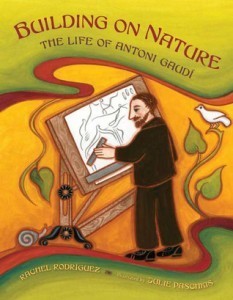 Building on Nature: The Life of Antoni Gaudi by Rachel Rodriguez, illustrated by Julie Paschkis – A too little remembered but really quite good picture book biography of the man responsible for a great number of buildings in Barcelona. The illustrations of Ms. Paschkis are luminous and do a darned good job at bringing the man’s work to life. I had the vague notion of bringing the book along with me to Spain (my 6-year-old niece will be joining us, and I figured she might get a kick out of it), but my hold didn’t arrive on time. Alas for me, but useful for anyone else who might be traveling to that neck of the world.
Building on Nature: The Life of Antoni Gaudi by Rachel Rodriguez, illustrated by Julie Paschkis – A too little remembered but really quite good picture book biography of the man responsible for a great number of buildings in Barcelona. The illustrations of Ms. Paschkis are luminous and do a darned good job at bringing the man’s work to life. I had the vague notion of bringing the book along with me to Spain (my 6-year-old niece will be joining us, and I figured she might get a kick out of it), but my hold didn’t arrive on time. Alas for me, but useful for anyone else who might be traveling to that neck of the world.
And so I go. Fear not, I’ll be posting interim posts during my absence. Now if you’ll excuse me, I believe I have a plane to catch.
April 2, 2013
A Children’s Book Fever Dream: Compounding Awesome Upon Awesome
 There are some days when you are so utterly floored by delight that all you can do is throw up your hands and say to the universe, “I’m out!” That was yesterday. I’m out, folks. I hit the top. It’s all downhill from here. And I’m so young! It’s sad when you peak at 34.
There are some days when you are so utterly floored by delight that all you can do is throw up your hands and say to the universe, “I’m out!” That was yesterday. I’m out, folks. I hit the top. It’s all downhill from here. And I’m so young! It’s sad when you peak at 34.
The source of this joy/woe is Allie Bruce at the Bank Street School for Children’s library. As you may know, if you attended my Children’s Literary Salon on Alternative Children’s Librarians, Allie is Bank Street’s children’s librarian and a more talented young ‘un you could not hope to find. She asked me if I could come in one day to speak to some of her sixth graders about book jackets. And since that is a topic I could talk about all day and night, I readily agreed.
Oh. And while I was there, Lemony Snicket/Daniel Handler and Jon Klassen would stop by to do their very first dual presentation of their new book The Dark.
But wait. There’s more.
Neil Gaiman would also be stopping by. And Mr. Handler’s wife Lisa Brown. And Jon Scieszka might come along. As well as Kerlan Collection guru Lisa Von Drasek (newly appointed as a National Book Award committee judge).
So . . . there was that.
That morning I headed on over with my handy dandy FlashDrive, forgetting to bring my camera. Luckily everything in my purse is a camera these days. My phone is a camera. My iPod is a camera. My lipstick, extra shoes, and hairbrush may all well have cameras in them, for all I know.
My presentation seemed to go all right. Allie was nice about it anyway, and though I was mildly unnerved when Lisa Von Drasek appeared, taking a picture with an iPad (it is hard to stay calm in the face of a large flat surface aimed at your head) I didn’t panic once. For the record, the kids assured me that none of them liked the old cover of Okay for Now and did prefer the new paperback jacket. They also agreed with me that the British cover of Dead End in Norvelt by Jack Gantos is heads and tails more interesting than the American one. Duh.
When I was done I got to flit about. In my flitting I saw that the Bank Street library’s children’s librarian’s office contains an ancient Jon Scieszka mask of yore. The kind of mask that reminds you of Eraserhead more than anything else. The mask is Lisa Von Drasek’s by right, and she had a fascinating story about when it was made and its original purpose. Apparently when it first came out it was handed to a roomful of librarians. Jon knew nothing about it and he walked in to see his own visage staring back at him from hundreds of faces. “It was like Being John Malkovich“, he said. Allie assured me that the kids who see it are fascinated. Sometimes they commune with it on a near spiritual level.
Jon Klassen and Daniel Handler were slated to start signing a bunch of copies of their book but until they did we figured we’d hang out in The Quiet Room (which proved to be a bit of a misnomer). I don’t own a clutch. Not really. So in lieu of one I tend to carry around a book. Thus it was that the galley of Merrie Haskell’s Handbook for Dragon Slayers got lugged, poor thing, hither and thither, as I stuffed an interesting assortment of business cards, flyers, and Starbucks napkins into its pages. Apparently I was worried that I’d have nothing to do and would need some entertainment. Oh, the wrongness of little me.
Jon, Daniel, the remarkable Lisa Brown, her thoroughly enjoyable offspring (who had written one helluva graphic novel illustrated by his mom), Victoria Stapleton in shoes I should have caught on film, and a whole host of other folks flooded in. Before long it was lunch. Picture, if you will, what it is like to eat lunch across from Scieszka and Handler with Lisa Brown at your side and Lisa Von Drasek heading the table. I am not particularly good at socializing when overwhelmed. I tend to get giggly. And loud. And I make strange little jokes that feed off of references that make sense only in my own head. So while I was not particularly interesting at this gathering, the rest of the folks were superb. In the future I’m taking my little audio recorder with me to capture this kind of situation on tape for the benefit of future generations. See if I don’t.
 So then Neil Gaiman comes in. That was nice. He’s a bit beardy right now. Much with the stubble, which has a pleasant graying sheen to it. Shocker: He wore black. I’m not shy around famous folks, but Gaiman is a tricky one. He’s a very kind famous person. If you introduce yourself to him he’ll look you dead square in the eye, shake your hand, and seem interested in whatever babble proceeds to emanate from your mouth. But famous people on his level are a bit difficult to converse with casually, and because they are at a distinct disadvantage to you (you know who they are, but they meet hundreds of people every day and can’t remember you as well) you can’t rely on them remembering any past conversations you might have had. So I just skipped the whole meet Gaiman part of the day and chatted with Jon Klassen instead. And Jon is a true doll. The kind of guy you’d try to weasel yourself into sitting next to at a dinner party. I’m trying to pin down exactly what his personality reminds me of, but it’s hard. In any case, I lamented with him that he’d used such great material on his Boston Horn Book Globe Award speech now that he had to write a Caldecott one (he’s almost done with it, Roger, don’t worry!).
So then Neil Gaiman comes in. That was nice. He’s a bit beardy right now. Much with the stubble, which has a pleasant graying sheen to it. Shocker: He wore black. I’m not shy around famous folks, but Gaiman is a tricky one. He’s a very kind famous person. If you introduce yourself to him he’ll look you dead square in the eye, shake your hand, and seem interested in whatever babble proceeds to emanate from your mouth. But famous people on his level are a bit difficult to converse with casually, and because they are at a distinct disadvantage to you (you know who they are, but they meet hundreds of people every day and can’t remember you as well) you can’t rely on them remembering any past conversations you might have had. So I just skipped the whole meet Gaiman part of the day and chatted with Jon Klassen instead. And Jon is a true doll. The kind of guy you’d try to weasel yourself into sitting next to at a dinner party. I’m trying to pin down exactly what his personality reminds me of, but it’s hard. In any case, I lamented with him that he’d used such great material on his Boston Horn Book Globe Award speech now that he had to write a Caldecott one (he’s almost done with it, Roger, don’t worry!).
Then it was time for the presentation! We proceeded to the Bank Street auditorium, which was apparently built on the side of a mountain. It’s one of those auditoriums where you get the distinct feeling that if you tripped and fell down the stairs they’d have to pluck your various limbs out of the four corners of the room post-landing. We sat up top, the kiddos sitting beneath us, closer to the stage. And what lively kiddos they were too! I suspect they were fresh off of lunch and had had their fill of pudding pops or whatever it is kids eat today (Note to Self: Check and see if pudding pops still exist . . . ditto Hydrox cookies). They were bouncy. Very bouncy. Tres bouncy. Handler played some background music for them which, interestingly, did not seem to affect them one way or another. And so the fun began.
Now Daniel and Jon had never presented together. Their PowerPoint presentation had not even been finished as of the night before. And here they were, with Gaiman, ready to wow a room on a brand new book for the very first time.
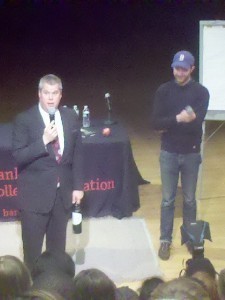 Ladies and gentlemen, let us discuss the nature of comedic chemistry. Think of all the great pairings of the past. Mel Brooks and Carl Reiner. Jerry Lewis and Dean Martin. Tina Fey and Amy Poehler. Now think of the great comedic children’s book pairings out there. Jon Scieszka and Lane Smith. Mac Barnett and Adam Rex. Amy Krouse Rosenthal and Tom Lichtenheld (they get extra points for playing ping pong while they present). But on this day we witnessed something new. Something unique. We witnessed, ladies and gentlemen, the greatest comic picture book pairing the world has ever seen. I mean this honestly.
Ladies and gentlemen, let us discuss the nature of comedic chemistry. Think of all the great pairings of the past. Mel Brooks and Carl Reiner. Jerry Lewis and Dean Martin. Tina Fey and Amy Poehler. Now think of the great comedic children’s book pairings out there. Jon Scieszka and Lane Smith. Mac Barnett and Adam Rex. Amy Krouse Rosenthal and Tom Lichtenheld (they get extra points for playing ping pong while they present). But on this day we witnessed something new. Something unique. We witnessed, ladies and gentlemen, the greatest comic picture book pairing the world has ever seen. I mean this honestly.
For you see, Mr. Handler had noticed something about Mr. Klassen. He is a world class straight man. A good straight man is exceedingly difficult to find. You need someone who enjoys the spotlight but hasn’t the kind of ego that demands that they grab it away from their partner. They need to be willing to be made a fool of, but the wit and cunning to turn it all around on their partner by the end. In short, you need a Jon Klassen.
The entire schtick hinged on the idea that Mr. Handler (who proclaimed repeatedly that he was not Lemony Snicket to the pained cries of the delighted audience members) had zero respect for Mr. Klassen’s work on their book together. In the course of their talk he disparaged Mr. Klassen’s clothes and talent. Klassen, for his part, played along beautifully. They alternated seemingly random slides of varying importance. It was fairly clear that the slides were a combination of Handler’s old standbys (he’s in an old photograph phase right now that’s doing very well by him) with Klassen’s (in which he shows various important pieces of art from his youth, including a shot of Frog & Toad, and repeats how frightened he was of them when he was a child).
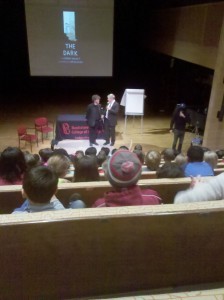 When Mr. Snicket starts to read the book with Mr. Klassen illustrating alongside him, the tension escalates. Handler denies Mr. Klassen the shiny red apple he’d really like to eat. He blindfolds him and makes him draw sans eyes. He brings on Gaiman and claims he’s now going to read the book in his best Neil Gaiman imitation (Klassen makes fun of the “imitation” continually). And then, when everything is reaching a crescendo . . . Klassen turns everything on its head and Handler runs off screaming. I won’t give away why. Bank Street recorded the whole thing and I’ll post it here when I can.
When Mr. Snicket starts to read the book with Mr. Klassen illustrating alongside him, the tension escalates. Handler denies Mr. Klassen the shiny red apple he’d really like to eat. He blindfolds him and makes him draw sans eyes. He brings on Gaiman and claims he’s now going to read the book in his best Neil Gaiman imitation (Klassen makes fun of the “imitation” continually). And then, when everything is reaching a crescendo . . . Klassen turns everything on its head and Handler runs off screaming. I won’t give away why. Bank Street recorded the whole thing and I’ll post it here when I can.
The kids, for the record, ate this thing up like it was a (perhaps nonexistent) pudding pop. They laughed. They screamed. Mostly they screamed. I’m not entirely certain if Handler and Klassen (and Gaiman for that matter) were ready for the level of identification the kids made with poor Mr. Klassen. Handler told his blindfolded illustrator that both of them would blindfold themselves and then read and draw without their eyes. This was, of course, a lie and the kids could not help but scream to Mr. Klassen that Mr. Handler was welching on his half of the deal. There was an interesting level of desperation to their cries. Handler’s an old hand in dealing with child panic and outrage, but Klassen dealt with it beautifully as well. It was very satisfying to watch. You should have heard les enfants terrible when Handler started eating Jon’s apple.
When the video is up and running I will let you know. It’ll make your day. Meantime, a big thank you to the folks at Little, Brown for bringing these heavyweights together and to Bank Street for hosting them. And thanks, of course, to Allie Jane Bruce for inviting me and allowing me to report on what, without a doubt, was the highlight of the year. Methinks I’ll go off and relive it a couple times just for kicks.
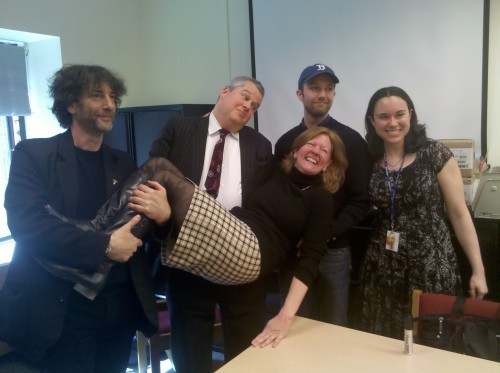
Jenny Brown living the dream with Allie Bruce close by.
April 1, 2013
Fusenews: This is what a librarian looks like
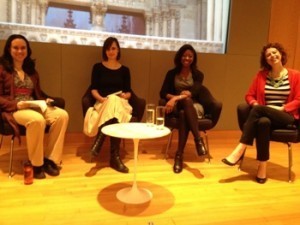 Oh me, oh my, where does the time go? Here we are, it’s Monday yet again, and I’m running about like a chicken with my head cut off. This Friday I head off to Barcelona for a full week (weep for me), then back I come to promote my picture book (Giant Dance Party, or haven’t I mentioned it before?), but not before I’ve finished the promotional videos and my very first website. *pant pant pant*
Oh me, oh my, where does the time go? Here we are, it’s Monday yet again, and I’m running about like a chicken with my head cut off. This Friday I head off to Barcelona for a full week (weep for me), then back I come to promote my picture book (Giant Dance Party, or haven’t I mentioned it before?), but not before I’ve finished the promotional videos and my very first website. *pant pant pant*
With that in mind, let’s get through these mighty quick. Not that they don’t all deserve time and attention. And tender loving care. Mwah! Big kisses all around! And yes, I did consider doing an April Fool’s post today but thought better of it. If you’d like to see some of the greatest April Fool’s posts of the children’s literary world, however, please be so good as to head over to Collecting Children’s Books and read the ones that Peter Sieruta came up with. There was 2012′s post (“Selznick syndrome” is just shy of brilliant), 2011′s Charlie Sheen Lands Children’s Book Deal (still feels real), 2009′s Graveyard Book to Be Stripped of Newbery, and his 2008 Ramona piece de resistance. This is the first year he won’t have one up. Miss you, Peter.
So I had a crazy idea for a Children’s Literary Salon panel at NYPL. Heck, I didn’t even know if anyone would show up, but I invited four different children’s librarians from four very different alternative children’s libraries. Don’t know what an alternative children’s library is? Then read this SLJ write-up NYPL Panelists Explore Alternatives to Traditional Librarianship. The happy ending is that lots of people attended and the conversation was scintillating. And timely. A nice combination.
Another good combination? Me and my husband. And it seems the resident husband recently wrote a blog piece that could be of use to you writer types out there. How To Write Every Day, Conclusion: Is Your Goal to Keep Writing or Stop Writing? should give you enough fodder to chew on for the next year or so. Then I’ll tell you about another one of his posts. Trust me when I say they’re all this good.
Did your stomach lurch a little when you found out that Amazon bought Goodreads? Well, how much should you care? Dan Blank has some answers. In Short: Don’t you worry ’bout nothing (he says it nicer than that).
A contact recently mentioned that they would like to give a little attention to the children’s book art auction at Book Expo, a yearly event that actually isn’t particularly well known. Said they (take note!):
The American Booksellers Foundation for Free Expression is an organization that fights book censorship. We mostly work with booksellers, however, in Our Kids Right To Read Project, we advocate for kids when people try to ban books in libraries or classrooms. Our position is that parents have the right to decide what their own children read but they do not have the right to decide for others. Proceeds from the auction will go to our programming. Our website is www.abffe.org and for the auction we have set up a separate page where people can buy tickets and artists can donate art. It is: http://abffesilentauction.wordpress.com/.
More me stuff. Over at Tor.com I answer the great ponderable facing the world of children’s literature today: Why are dinosaurs so darn popular? The answer may surprise you. Okay . . . that’s a lie. You know why. But at the very least I’m able to draw some conclusions you may not have necessarily come up with before. It all comes down to Freud, baby.
I’ve a friend who passes along Common Core oddities she picks up on in the news. This week it was a tough call. Which was better? The article that said, “Alabama cannot retain its education sovereignty under Common Core” or Glenn Beck’s even nuttier-than-usual screed against CCS saying that they’ll result in 1984-type changes to the educational system? Honestly, do we even have to choose?
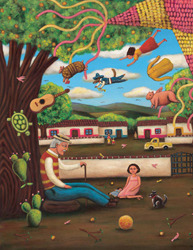 On the flipside, how cool is this? The Eric Carle Museum has a simply lovely exhibit up right now called Latino Folk Tales: Cuentos Populares-Art by Latino Artists. As if you needed an excuse to visit. But just in case you did . . .
On the flipside, how cool is this? The Eric Carle Museum has a simply lovely exhibit up right now called Latino Folk Tales: Cuentos Populares-Art by Latino Artists. As if you needed an excuse to visit. But just in case you did . . .
I haven’t gotten much from Cynopsis Kids lately for the old blog, but there was this little tidbit I almost missed the other day: “Montreal-based Sardine Productions will develop a children’s television show based on The Mammoth Academy, a book series by British author and illustrator Neal Layton, with TVOKids, a division of Ontario’s public educational media organization TVO.”
Meanwhile, from PW Children’s Bookshelf, this little nugget of very cool news: “Anne Hoppe at Clarion Books has acquired North American rights to a nonfiction picture book by Katherine Applegate about Ivan the gorilla, the subject of her Newbery Medal-winning The One and Only Ivan. Elena Mechlin at Pippin Properties represented Applegate. In a separate deal, Mechlin sold North American rights to two middle-grade novels by Applegate, to Jean Feiwel and Liz Szabla at Feiwel and Friends.” Well that’s 12 kinds of brilliant. And how clever of Hoppe to get Applegate for Clarion. She’ll do well there. Nonfiction always does.
I don’t know about you but I was thrilled to see The New York Times write a piece on Rachel Renee Russell. When we talk about bestselling children’s books it seems odd to me that no one ever points out that the top series in children’s literature (rather than YA) right now that is written by a woman is also written by an African-American woman. Now I just want to know who the famous author was that discouraged her from writing when she was in college!
Daily Image:
Flavorwire always has such good ideas. Example: 20 Bookish Murals From Around the World. A taste:
Thanks to AL Direct for the link.
March 26, 2013
Reading Too Much Into It: When Simple Picture Book Plots Take on Lives of Their Own
Excluding the very rare exceptions here and there, it’s fairly safe to say that when picture books are adapted into big screen movie sensations they are inevitably packed to the gills full of unnecessary awfulness. Consider the fate of The Cat in the Hat if you doubt me at all. Now there are exceptions to every rule, but for every Where the Wild Things Are there are twenty or so live action How the Grinch Stole Christmases to take their place (Seuss books are particularly egregious offenders in this way).
My philosophy is, if you can’t beat ‘em, join ‘em. And as the mother of an almost two-year-old with an irrepressible appetite for picture book and easy book fare (not that there are any attempts at repressing being made) I’ve found that if a parent reads a book over and over enough that parent will start to construct elaborate subplots and backstories for the characters. Here then are some backstories you could easily turn into full-length feature films. If you had to, anyway.
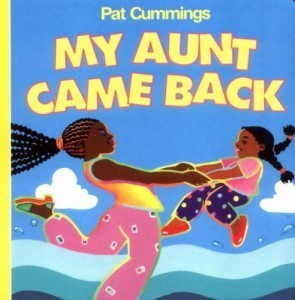 My Aunt Came Back by Pat Cummings – I see Will Smith producing this one, and I’m not even joking about this. The plot, if you’re familiar with it, consists of a young girl’s recitation of the different things her aunt has given her after her worldwide trips. Example: “My aunt came back from Timbuktu / She brought me back a wooden shoe.” Read the book enough times, though, and one fact is crystal clear. The aunt is an international spy. Of course she is! She’s going to Pakistan one day and Beijing the next and then leaving clues and pieces of evidence with her unsuspecting niece. This interpretation gives a whole different feeling to the end of the book where the girl says gleefully, “But this time she’s taking me too”. As a alibi, undoubtedly. Clever aunt. By the way, who’s a person gotta kill around here to get this board book back in print? Seriously, the fact that I can’t order new copies of this for my library system is a crime against man.
My Aunt Came Back by Pat Cummings – I see Will Smith producing this one, and I’m not even joking about this. The plot, if you’re familiar with it, consists of a young girl’s recitation of the different things her aunt has given her after her worldwide trips. Example: “My aunt came back from Timbuktu / She brought me back a wooden shoe.” Read the book enough times, though, and one fact is crystal clear. The aunt is an international spy. Of course she is! She’s going to Pakistan one day and Beijing the next and then leaving clues and pieces of evidence with her unsuspecting niece. This interpretation gives a whole different feeling to the end of the book where the girl says gleefully, “But this time she’s taking me too”. As a alibi, undoubtedly. Clever aunt. By the way, who’s a person gotta kill around here to get this board book back in print? Seriously, the fact that I can’t order new copies of this for my library system is a crime against man.
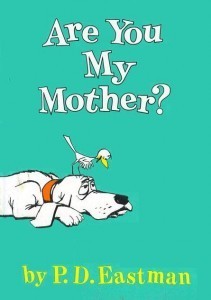 Are You My Mother? by P.D. Eastman – Full credit to my brother-in-law for pointing out what this book is really about. Have you guys noticed that dystopian and post-apocalyptic tales are everywhere? Well, meet the original post-apocalyptic hellscape that serves as the backdrop to this tale. A baby bird searches a scorched earth for his mother, encountering various still living reminders of a world that once was. About the point you get to the abandoned (some might say burned out) car you get suspicious. The only signs of human existence are a distant boat at the bottom of a cliff and the scary snort that never reveals itself to be anything but sentient metal. In fact, that’s how I see the book. The machines rebelled against man and war broke out. The humans were all put down and now the world is ruled by diggers and cars and various forms of transportation. They leave the animals in peace, but that’s because none of them have ever shown signs of intelligence. That is . . . until the birth of a singular baby bird! Bum bum BUMMMMM.
Are You My Mother? by P.D. Eastman – Full credit to my brother-in-law for pointing out what this book is really about. Have you guys noticed that dystopian and post-apocalyptic tales are everywhere? Well, meet the original post-apocalyptic hellscape that serves as the backdrop to this tale. A baby bird searches a scorched earth for his mother, encountering various still living reminders of a world that once was. About the point you get to the abandoned (some might say burned out) car you get suspicious. The only signs of human existence are a distant boat at the bottom of a cliff and the scary snort that never reveals itself to be anything but sentient metal. In fact, that’s how I see the book. The machines rebelled against man and war broke out. The humans were all put down and now the world is ruled by diggers and cars and various forms of transportation. They leave the animals in peace, but that’s because none of them have ever shown signs of intelligence. That is . . . until the birth of a singular baby bird! Bum bum BUMMMMM.
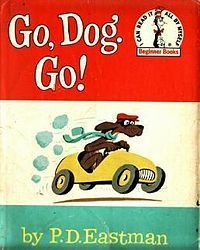 Go, Dog, Go! by P.D. Eastman – If you can sit through futuristic P.D. Eastman then you can certainly sit through a glimpse into the world of Go, Dog, Go! that I would have missed had it not been (again) thanks to my brother-in-law. The book consists of many dogs doing many things and they all appear, for the most part, to be male. The exception lies in two dogs that have this strange little exchange throughout the book. One will ask if her friend likes her hat. He’ll bluntly say no and they’ll move on. And this continues four or five times until, at last, at a wild party he tells her he likes her hat and she drives away in his car. Not the greatest moral, but you begin to wonder what the nature of their relationship really is. I see them as kind of the When Harry Met Sally of the easy book world. But if she has any guts she’ll leave him cold and soon. That boy’s no good, honey. Worse, he has terrible taste in hats.
Go, Dog, Go! by P.D. Eastman – If you can sit through futuristic P.D. Eastman then you can certainly sit through a glimpse into the world of Go, Dog, Go! that I would have missed had it not been (again) thanks to my brother-in-law. The book consists of many dogs doing many things and they all appear, for the most part, to be male. The exception lies in two dogs that have this strange little exchange throughout the book. One will ask if her friend likes her hat. He’ll bluntly say no and they’ll move on. And this continues four or five times until, at last, at a wild party he tells her he likes her hat and she drives away in his car. Not the greatest moral, but you begin to wonder what the nature of their relationship really is. I see them as kind of the When Harry Met Sally of the easy book world. But if she has any guts she’ll leave him cold and soon. That boy’s no good, honey. Worse, he has terrible taste in hats.
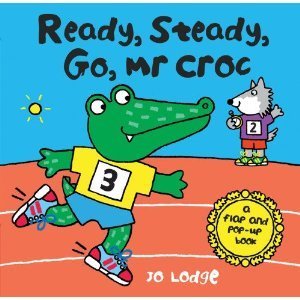 Ready, Steady, Go, Mr. Croc! by Jo Lodge – I don’t mind telling you that this British import with its enormously clever paper constructions was derailed for me (slightly) when my husband pointed that that Mr. Croc’s wolf friend Wilf had a name that sounded suspiciously similar to Wolf I’d Like to F***. Wilf. Yeah, ask me if I’m even capable of saying the poor guy’s name now without giggling. And that’s before I noticed the sheer number of relationships going on in these books. The Mr. Croc titles are probably where you can pinpoint my descent into madness. Several of his books involve his friends, and I’ve started to construct these intricate relationship notes between characters. Clearly Lulu the cheetah and Wilf have a thing for one another, but Lulu’s rich (she owns a plane and excels at tennis) and Wilf still works on a farm. Can their love survive? As for Elsie the elephant, I suspect that she’s been pining for Zebedee the zebra, but it’s all for naught at this point. Moving on . . .
Ready, Steady, Go, Mr. Croc! by Jo Lodge – I don’t mind telling you that this British import with its enormously clever paper constructions was derailed for me (slightly) when my husband pointed that that Mr. Croc’s wolf friend Wilf had a name that sounded suspiciously similar to Wolf I’d Like to F***. Wilf. Yeah, ask me if I’m even capable of saying the poor guy’s name now without giggling. And that’s before I noticed the sheer number of relationships going on in these books. The Mr. Croc titles are probably where you can pinpoint my descent into madness. Several of his books involve his friends, and I’ve started to construct these intricate relationship notes between characters. Clearly Lulu the cheetah and Wilf have a thing for one another, but Lulu’s rich (she owns a plane and excels at tennis) and Wilf still works on a farm. Can their love survive? As for Elsie the elephant, I suspect that she’s been pining for Zebedee the zebra, but it’s all for naught at this point. Moving on . . .
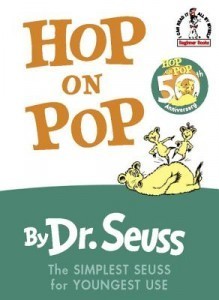 Hop on Pop by Dr. Seuss – Any Dr. Seuss book lends itself to interpretation. That’s why we’ve such terrible movies of them out there. Hop on Pop rivals Go, Dog, Go! in random chicanery, but there is one storyline in there that I’m particularly interested in. That would be the saga of Mr. and Mrs. Brown. Mr. Brown appears to be happily married to Mrs. Brown until one day in a chance accident involving a see-saw he’s flung out of town. When he comes back he’s suddenly quite close to a mysterious Mr. Black. Are they in love? Is Mr. Black just his rabbi? Pup’s not talking but Mrs. Brown is nowhere in sight. What is going on here?
Hop on Pop by Dr. Seuss – Any Dr. Seuss book lends itself to interpretation. That’s why we’ve such terrible movies of them out there. Hop on Pop rivals Go, Dog, Go! in random chicanery, but there is one storyline in there that I’m particularly interested in. That would be the saga of Mr. and Mrs. Brown. Mr. Brown appears to be happily married to Mrs. Brown until one day in a chance accident involving a see-saw he’s flung out of town. When he comes back he’s suddenly quite close to a mysterious Mr. Black. Are they in love? Is Mr. Black just his rabbi? Pup’s not talking but Mrs. Brown is nowhere in sight. What is going on here?
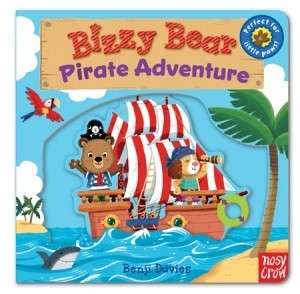 The entire Bizzy Bear series by Benji Davies – Like the Mr. Croc series, Bizzy Bear is a British import that lends itself to WAY too many thoughts in my head. Bizzy participates on a construction crew in one book and takes a vacation in another. Nothing mind boggling. I read quite a few of his books before I realized something. Bizzy’s got a thing for pretty lady dogs. In his pirate adventure, his firefighting outing, and his vacation Bizzy ends up in the company of a pretty dog, though it never appears to be the same dog twice. The man knows what he likes, I’ll give him that much.
The entire Bizzy Bear series by Benji Davies – Like the Mr. Croc series, Bizzy Bear is a British import that lends itself to WAY too many thoughts in my head. Bizzy participates on a construction crew in one book and takes a vacation in another. Nothing mind boggling. I read quite a few of his books before I realized something. Bizzy’s got a thing for pretty lady dogs. In his pirate adventure, his firefighting outing, and his vacation Bizzy ends up in the company of a pretty dog, though it never appears to be the same dog twice. The man knows what he likes, I’ll give him that much.
Now I’m off to go read some A.S. Byatt, because much more of this and you’ll start to see me mouthing off about the hidden meanings found in Knuffle Bunny. Trust me when I say you do NOT want to be around for that.
March 25, 2013
Sneaky Peek: A Glimpse of Platypuses Packing Heat/Boomerangs
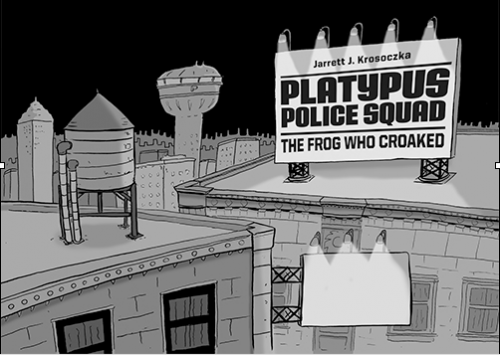 There are certain words and phrases that are instantly hilarious. Kalamazoo is one of them. Platypus is another. All the more reason to combine the two. That’s my logic. When I heard that Jarrett Krosoczka (he of the Lunch Lady GN series as well as a stunner of a TED talk, amongst other accomplishments), had a buddy cop middle grade coming out called Platypus Police Squad: The Frog Who Croaked, I had to have it. And as luck would have it, it’s great. Why no one has ever thought to do a buddy copy chapter book (if you can name me one other you earn yourself a cookie) I do not know. Clearly it’s meant to be.
There are certain words and phrases that are instantly hilarious. Kalamazoo is one of them. Platypus is another. All the more reason to combine the two. That’s my logic. When I heard that Jarrett Krosoczka (he of the Lunch Lady GN series as well as a stunner of a TED talk, amongst other accomplishments), had a buddy cop middle grade coming out called Platypus Police Squad: The Frog Who Croaked, I had to have it. And as luck would have it, it’s great. Why no one has ever thought to do a buddy copy chapter book (if you can name me one other you earn yourself a cookie) I do not know. Clearly it’s meant to be.
Folks at Walden Media got wind that I liked the book (review forthcoming) and asked if I’d like to premier some of the art. The book’s not slated for shelves until May 7th so here’s a bit of a peek into some of the pieces I’m particularly fond of and why.
So first off, the book is set in Kalamazoo City, which is not to be confused with Kalamazoo, Michigan (my beloved hometown). Here’s a bit of a glimpse into some of the lower income parts of the city. From what I can tell, Kalamazoo City sports a pretty large population. One of our heroes in the book lives here.
I refer to the book as in the “buddy cop” style, but as you can see, Krosoczka isn’t averse to dropping a bit of noir in as well.
Then there’s the standard getting-dressed-down-by-the-chief scene. Of which this book had in abundance. I like this shot.
Should I read too much into the fact that the librarian in this book is a bird? A bird with a thing for young handsome platypuses, no less. She clearly has good taste. I’m going to lay claim to her in any case.
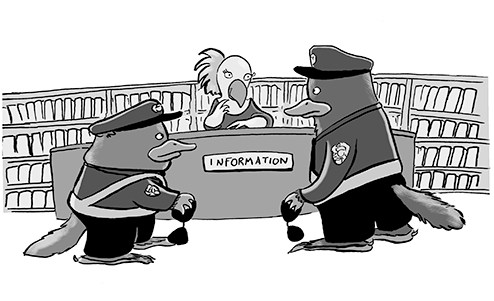 It’s like me mudda always used to say: Never trust a koala. Particularly a koala sporting elastic on his upper arms..
It’s like me mudda always used to say: Never trust a koala. Particularly a koala sporting elastic on his upper arms..
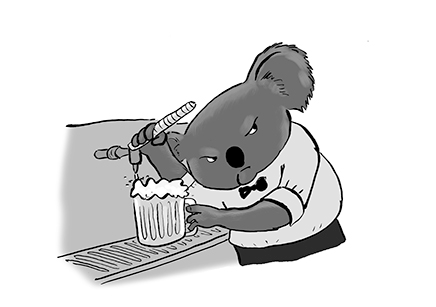
This just a small smattering, but it gives you a taste for the book in its entirety. Thanks to Walden Media for letting me show you the goods. It’s a grand little book. No fooling.
March 24, 2013
Review of the Day: Brick by Brick by Charles R. Smith Jr.
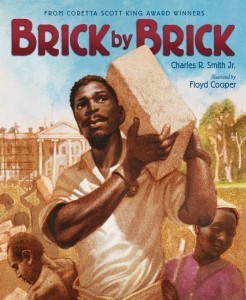 Brick by Brick
Brick by Brick
By Charles R. Smith Jr.
Illustrated by Floyd Cooper
$17.99
ISBN: 978-0-06-192082-0
Ages 4-8
On shelves now
Sometimes I feel like the older I get the more interesting history becomes. Not that history, real history, wasn’t always fascinating. It’s just that when I was a kid you couldn’t have named a subject duller. And why not? Insofar as I knew, the history taught in my schools gave me the distinct impression that America was a country forged by white people and that folks of any other race would crop up occasionally in the textbooks to be slaves or to appear in internment camps or to suffer Jim Crow. If anything came up about post-Revolutionary War America it was a pretty dry recitation of more white people doing whatever it was that they did. So for me the recent bumper crop of children’s books seeking to undo some of this damage is positively heady. Whether it’s works of historical fiction based in fact like Chains by Laurie Halse Anderson and Jefferson’s Sons by Kimberly Brubaker Bradley, or fascinating works of nonfiction like Master George’s People by Marfe Ferguson Delano, we live in an era where kids can get a fuller, if not entirely complete, look at what has typically been a whitewashed era in their history books. For the younger sorts we have, Brick by Brick, a book that shines a light on something that I’m not even sure my own second grade teacher even knew, back in the day. Doesn’t hurt matters any that it’s gorgeous to boot.
“Under a hazy, / hot summer sun, / many hands work / together as one.” The time has come for the President of the United States of America to have a home to live in. So it is that white workers and free black workers are joined by slave labor to get the job done. In highlighting their work, poet and author Charles R. Smith Jr. focuses squarely on the hands of the laborers. Gentle rhyming text tells the tale, pulling in facts along the way. For example, we see that some of the more skilled laborers earned shillings that went towards buying their freedom. The house is built and the people look forward to a day when they won’t have to be slaves any long. Some factual backmatter appears at the end.
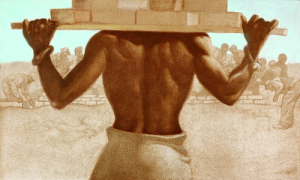 Last year we actually saw a book that was relatively similar to this one. Called The House That George Built it was by Suzanne Slade and raised hackles on my hackles when I read it. I was fresh off having watched the HBO John Adams series and it seemed to me an utter waste that Slade would write a whole book about the construction of the White House without giving additional attention to the sheer irony inherent in the fact that its very creation rested in large part on the backs of slaves. To be fair, Slade did mention the slave workers and her book had a broader scope in mind. Still, I read it and wanted it to be something else. And the something else I wanted, as it turned out, was Brick by Brick. I just didn’t know it yet.
Last year we actually saw a book that was relatively similar to this one. Called The House That George Built it was by Suzanne Slade and raised hackles on my hackles when I read it. I was fresh off having watched the HBO John Adams series and it seemed to me an utter waste that Slade would write a whole book about the construction of the White House without giving additional attention to the sheer irony inherent in the fact that its very creation rested in large part on the backs of slaves. To be fair, Slade did mention the slave workers and her book had a broader scope in mind. Still, I read it and wanted it to be something else. And the something else I wanted, as it turned out, was Brick by Brick. I just didn’t know it yet.
Smith’s poetry sometimes stands second to his writing, if that makes any sense. He’s a great writer. Knows precisely what to highlight and how to highlight it. But I think it was the Booklist review of this title that mentioned that the rhythm sometimes feels “clunky, and the slant rhyme feels unintentional”. This is not untrue., though to be honest I had no trouble with the rhythm myeslf. But there are times when you’re not quite sure what Smith is going after. For example, there are two lists of names in the book. The first time you read the list, the slant rhyme works (“Len” and “Jim”). The second time you can’t help but wonder if it was supposed to rhyme at all (“Moses” and “Thomas”). That said, let’s get back to that writing, eh? Listen to this section:
“Chiseling, carving,
and transporting stone,
slave hands ache,
dark skin to white bone.”
Now that is down and out beautiful. It really is. Dark skin to white bone. And the book is just chock full of little lines like that. This is what sets “Brick by Brick” apart from a lot of nonfiction fare for younger kids. Why can’t children get their facts wrapped up in beautiful packaging? Why can’t something be both accurate and poetic? As a work of nonfiction, there is sadly little backmatter to be had. Smith doesn’t offer much more than a well-put answer to the question “Why Were Slaves Used to Build the White House?” He makes it clear that the house they built burned down in 1814, but that the contribution remains memorable. And he includes three Selected Resources, though sadly they all appear to be intended for adults. It would be nice if there had been something there specifically for children. Still, you go with what you’ve got.
And though it sounds odd, I cannot help but praise the author for not ending the book with Barack Obama. Don’t get me wrong, I’m perfectly happy with most nonfiction works for children bringing the man up. But as I neared the book’s end I had to swallow my sense of dread. A shot of the White House today with Obama and his family would feel forced and obvious if it were just stuck in there. Sure, it would drill home the point of the book on a certain level but (A) the White House that Barack lives in is not the same as the White House built by the slaves and (B) do you really want an author to just shoehorn in someone contemporary when the entire focus until that point was squarely on the past? More to the point, Smith is not inclined to hammer home points above and beyond the facts. He doesn’t go on at length about what the White House would have symbolized (or not) to the slave laborers. He lets the facts stand on their own merit, and if there are connections to be drawn that is up to the teachers and the kid readers themselves.
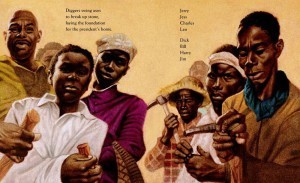 Floyd Cooper likes the color brown. He’s quite partial to it. If you yourself are not a fan of the color brown, I suspect that perhaps Cooper’s style may not be to your liking. But for those of us that consider his work a step above mere sepia, Cooper gives readers a chance to feel as though they are peering at actual historical scenes through the foggy lens of history. I’ve always enjoyed the sheer beauty of a Cooper book but with Brick by Brick I found myself admiring his faces more than usual. If Smith’s text gives life to the long dead, Cooper gives those same dead their humanity. In him the faceless acquire faces. There’s a spread early on where the workers look at the reader dead on with mixed expressions. Front and center is a boy, not much older than the kids who would be reading this book, wearing a white shirt that with a little choice hemming would not be out of place today. This kid is there to give the child reader a chance to look and maybe realize that history is a bit closer than they may think.
Floyd Cooper likes the color brown. He’s quite partial to it. If you yourself are not a fan of the color brown, I suspect that perhaps Cooper’s style may not be to your liking. But for those of us that consider his work a step above mere sepia, Cooper gives readers a chance to feel as though they are peering at actual historical scenes through the foggy lens of history. I’ve always enjoyed the sheer beauty of a Cooper book but with Brick by Brick I found myself admiring his faces more than usual. If Smith’s text gives life to the long dead, Cooper gives those same dead their humanity. In him the faceless acquire faces. There’s a spread early on where the workers look at the reader dead on with mixed expressions. Front and center is a boy, not much older than the kids who would be reading this book, wearing a white shirt that with a little choice hemming would not be out of place today. This kid is there to give the child reader a chance to look and maybe realize that history is a bit closer than they may think.
As for the faces themselves, Cooper gives fellow illustrators like Kadir Nelson a run for their money. These are people who have worked their entire lives. One wonders where he pulled these faces from. They’re not the folks you would necessarily pass on the street. There’s toil in the lines of their foreheads. There’s something in their eyes. It’s unique. In terms of accuracy, I cannot say whether or not the image of the White House that appears here (that looks very much like today’s White House) is an accurate depiction of the building that burned. All I can say is that Cooper’s work on this book looks great. It’s brown, but you won’t mind. Not a jot.
It’s baffling to think that a book on this topic hasn’t really been written for children before. There’s the aforementioned Slade title but a book that considers the contributions of slaves to the most famous house in America should unquestionably be everywhere. How to account for Smith’s as the first? You can’t. All you can do is be grateful that the book is as good as it is. With a plain purpose and no folderols or frippery to muck up the history, Smith and Cooper have crafted a work of nonfiction that might actually be interesting to those small fry forced to sit through a recitation of late 18th-century highlights. Beautiful in every which way, it’s a gross understatement to call this book long overdue. Call it necessary reading instead. For every library, everywhere.
On shelves now.
Source: Galley sent from publisher for review.
Like This? Then Try:
The House That George Built by Suzanne Slade, illustrated by Rebecca Bond
Dave the Potter by Laban Carrick Hill, illustrated by Bryan Collier
Master George’s People: George Washington, His Slaves, and His Revolutionary Transformation by Marfe Ferguson Delano
Heart and Soul: The Story of America and African Americans by Kadir Nelson
Other Blog Reviews:
A Wrung Sponge
Rhapsody in Books Weblog
Creative Madness Mama
A Mom’s Spare Time
Professional Reviews:
The New York Times
Kirkus
Publishers Weekly
Interviews:
Mr. Smith speaks with Jules at Seven Impossible Things Before Breakfast
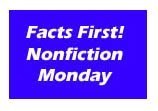
Misc:
It’s Nonfiction Monday! Check out Booktalking for the round-up.
Browse inside the book here,
Video:
Mr. Smith does a bit of booktalking on his own title. Can he booktalk everyone else too? He’s darn good at it.
March 20, 2013
Fusenews: Inordinately pleased that I got to work in the term “manky” today
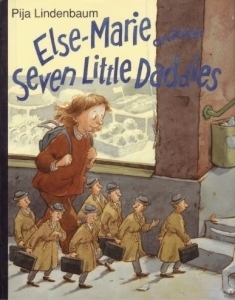 If you’ve received your latest edition of Horn Book Magazine then you may see that Roger and Co. had the clever notion to ask a bunch of folks what their favorite weirdo children’s books were. And as luck would have it, I was asked too. You can see my choice here if you like. If you missed your daily dose of Freud today, this wouldn’t be a shabby place to start. Failing that, I wrote a little write-up of my recent trip to the DC Entertainment offices, all thanks to the Women’s National Book Association. Which is to say, I got into the headquarters of MAD Magazine. Bucket List Objective #324: Check!
If you’ve received your latest edition of Horn Book Magazine then you may see that Roger and Co. had the clever notion to ask a bunch of folks what their favorite weirdo children’s books were. And as luck would have it, I was asked too. You can see my choice here if you like. If you missed your daily dose of Freud today, this wouldn’t be a shabby place to start. Failing that, I wrote a little write-up of my recent trip to the DC Entertainment offices, all thanks to the Women’s National Book Association. Which is to say, I got into the headquarters of MAD Magazine. Bucket List Objective #324: Check!Speaking of Horn Book (she said, backtracking wildly) Roger’s playing with delicious fire these days. I’m sure I don’t have to tell any of you that the Battle of the Kids’ Books is raging wildly over at my sister blog. I’m sort of with Kid Commenter in terms of my disappointment that so many YA books were paired in the first round with children’s titles and beating them soundly into pulp. That frustration is amended somewhat by the fact that Roger has been critiquing the critiques. The one for Appelt v. Caletti contains the single best sentence I’ve heard in the last 24 hours: “And I wish I never knew AND NOW I CAN’T UNLEARN IT that Laurie Halse Anderson called John Green ‘a holy man’.” Purrrr. Gidwitz v. Billingsley is similarly fascinating.
Digital prizes in countries that are not our own for works of children’s literature!! What more needs be said?
Oh good. New Gregor the Overlander covers are on the horizon. Don’t know about your but my copies have been getting a bit manky lately. Could do with a bit of a sprucing.
Laws. Only the New York Post would get on its crazy horse and start turning Jeanette Winter into a controversial figure. Have you heard the latest? New York approves war-oriented reading textbooks for third-grade classrooms. The culprit? The Librarian of Basra . I kid you not. One can only imagine what they’d do if they stumbled across Mark Alan Stamaty’s Alia’s Mission . Of far more interest to me is this interesting censoring pushback against books recommended with the Common Core in mind. If the Post article does anything of interest, it draws connections between these objections and the recent attempts by Chicago schools to ban Persepolis from 7th graders. These are good books and I think we could argue that they are being recommended for the right age groups because they are done exceedingly well. How many more similar objections are going to be raised because suddenly our kids aren’t all reading the same Johnny Tremain titles they’ve been assigned for the last fifty years? I think anyone who reads the books, and not just the sensationalized parts, would find them appropriate for the ages. But I suppose sometimes it’s easier to just get all Helen Lovejoy-ish. “Won’t somebody please think of the children?” Thanks to AL Direct for the link.
Along similar lines, SLJ is getting reading for its handy dandy webcast The Common Core and the Public Librarian. And normally I might not remember to mention such a thing (it’s happening Tuesday, April 9, 2013 – 3:00 PM ET) but that Olga Nesi, our local New York City Department of Education doyenne is going to talk about it alongside Nina Lindsay. Thing is, I have seen Olga speak about Common Core twice and I would see her do it a hundred times more. If she took her show on the road I would follow her around like a Dead Head, selling t-shirts that say things like “State Standards 4-EVAH” and the like. Ogla is THE number one person to listen to about this stuff and the fact that she’s going national, so to speak, is good for YOU. She makes this stuff not only make sense but she gets you excited about it. They should pump her into theaters like they do those Metropolitan Opera productions. She could fill stadiums. See her. Do. You can register here.
Anne Carroll Moore may have carried about a little wooden doll and hated Stuart Little (something I admit to being totally on board with), but the lady nailed children’s literature. That new little picture book about her, Miss Moore Thought Otherwise, is out soon and author Jeanne Walker Harvey reviews it here with copious mentions of my (former) children’s room/Ms. Moore’s old room.
MOCCA and the Society of Illustrators sitting in a tree. K-I-S-S-I-N-G. First comes love, then comes merger . . .
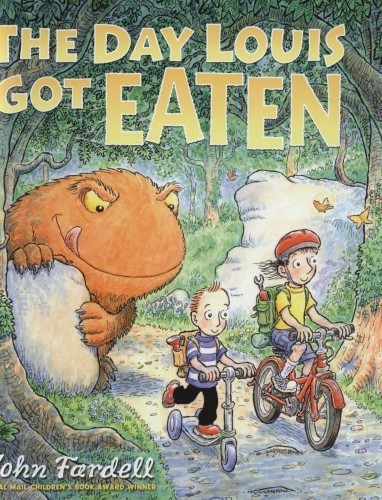 You know what I love? The Scottish. Which is a fairly all-encompassing statement so I’ll see what I can’t do about narrowing it down. Let’s try instead, you know what I love? The 2012 Scottish Children’s Book Awards which have JUST been given out. Or, as I like to call them, the upcoming Spring 2015 releases here in the States. Thanks to AL Directfor the link.From PW Children’s Bookshelf, my early Christmas present:
You know what I love? The Scottish. Which is a fairly all-encompassing statement so I’ll see what I can’t do about narrowing it down. Let’s try instead, you know what I love? The 2012 Scottish Children’s Book Awards which have JUST been given out. Or, as I like to call them, the upcoming Spring 2015 releases here in the States. Thanks to AL Directfor the link.From PW Children’s Bookshelf, my early Christmas present:“Two Lions, the picture book imprint of Amazon Children’s Publishing, has signed with Michael Hague to reissue 25 of his books in uniform editions as the Michael Hague Signature Classics Series. The books will be published in all formats: Kindle, enhanced Kindle, and hardcover and paperback print editions. The titles include Alice’s Adventures in Wonderland, Mother Goose, East of the Sun and West of the Moon, The Little Mermaid, The Secret Garden, Beauty and the Beast, Numbears, and many others.”
A good start. I grew up with Hague’s books. And for the record, I consider his The Wonderful Wizard of Oz to be a superior product to all other illustrated versions of the tale (take THAT Denslow, you walrus-mustached, foghorn-voiced, island hopper). And then there’s his The Lion, the Witch, and the Wardrobe. Somebody PLEASE bring that back to print. If it’s Amazon who does it, so be it. Just get me one for my branches and stat. Ditto The Wind in the Willows.
Daily Image:
And finally, the perfect gift for that kid who likes to read in bed but doesn’t like sitting up to do it. Or adult for that matter. LAZYGLAS.
Like little periscopes for your sight balls. Thanks to Mike Lewis for the link.
March 19, 2013
Press Release Fun: Children’s Choice Book Awards Voting Now Open!
THE CHILDREN’S BOOK COUNCIL AND EVERY CHILD A READER OPEN VOTING FOR THE CHILDREN’S
AND TEEN CHOICE BOOK AWARDS AT BOOKWEEKONLINE.COM
THE ONLY NATIONAL BOOK AWARDS PROGRAM WHERE THE WINNERS ARE
SELECTED BY YOUNG READERS OF ALL AGES
FOR IMMEDIATE RELEASE
New York, NY — March 19, 2013 – The Children’s Book Council and Every Child a Reader have opened voting for the 6th annual Children’s and Teen Choice Book Awards, the only national book awards program where the winning titles are selected by young readers of all ages, at www.bookweekonline.com. 30 finalists have been announced in six categories, representing kids’ and teens’ favorite books, authors, and illustrators of the year. Last year, almost 1,000,000 votes were cast, more than doubling votes from the previous year. Young readers can vote at www.bookweekonline.com or their votes may be tallied and entered by booksellers, librarians, and teachers into the group ballot at www.bookweekonline.com until May 9, 2013.
For the first time this year, the CBC has partnered with DOGObooks (www.dogobooks.com) to create free, embeddable voting widgets, expanding online voting opportunities for young readers everywhere. The widgets are available for publishers, librarians, teachers, and kid lit lovers at www.bookweekonline.com/widgets. DOGObooks will also promote the voting to millions of students and teachers through its award winning news site www.dogonews.com and through its partnerships with leading education platforms including Google Education, Edmodo and Edublogs.
The Children’s and Teen Choice Book Awards winners will be announced live at the 6th annual Children’s Choice Book Awards Gala on May 13 at the Liberty Theater in New York City. The gala is a charity event to benefit Every Child a Reader, and a hallmark event of Children’s Book Week (May 13-19, 2013), the longest-running national literacy initiative in the country. The awards presentation will be videotaped and available for viewing by book lovers of all ages after the event at www.bookweekonline.com.
The Children’s and Teen Choice Book Awards finalists are:
KINDERGARTEN TO SECOND GRADE BOOK OF THE YEAR
Big Mean Mike by Michelle Knudsen, illustrated by Scott Magoon (Candlewick)
The Duckling Gets a Cookie!? by Mo Willems (Hyperion Books/Disney)
I’ll Save You Bobo! by Eileen Rosenthal, illustrated by Marc Rosenthal (Atheneum Books for Young Readers/Simon & Schuster)
Pete the Cat and His Four Groovy Buttons by Eric Litwin, illustrated by James Dean (HarperCollins)
Nighttime Ninja by Barbara DaCosta, illustrated by Ed Young (Little, Brown)
THIRD GRADE TO FOURTH GRADE BOOK OF THE YEAR
Bad Kitty for President by Nick Bruel (Roaring Brook/Macmillan)
Get the Scoop on Animal Poop! by Dawn Cusick (Imagine/Charlesbridge)
Homer by Shelley Rotner, illustrated by Diane deGroat (Scholastic)
Just Joking by National Geographic Kids (National Geographic Children’s Books)
Pluto Visits Earth! by Steve Metzger, illustrated by Jared Lee (Scholastic)
FIFTH GRADE TO SIXTH GRADE BOOK OF THE YEAR
Dork Diaries 4: Tales from a Not-So-Graceful Ice Princess by Rachel Renée Russell (Aladdin/Simon & Schuster)
Liar & Spy by Rebecca Stead (Wendy Lamb Books/Random House)
Pickle: The (Formerly) Anonymous Prank Club of Fountain Point Middle School by Kim Baker, illustrated by Tim Probert (Roaring Brook/Macmillan)
Rebel McKenzie by Candice Ransom (Hyperion Books/Disney)
Stickman Odyssey, Book 2: The Wrath of Zozimos by Christopher Ford (Philomel/Penguin)
TEEN BOOK OF THE YEAR
Cinder (The Lunar Chronicles, Book 1) by Marissa Meyer (Feiwel & Friends/Macmillan)
City of Lost Souls (Mortal Instruments) by Cassandra Clare (Margaret K. McElderry Books/Simon & Schuster)
The Fault in Our Stars by John Green (Dutton/Penguin)
Insurgent by Veronica Roth (Katherine Tegen Books/HarperCollins)
Rapture: A Fallen Novel by Lauren Kate (Delacorte/Random House)
AUTHOR OF THE YEAR
John Green for The Fault in Our Stars (Dutton/Penguin)
Jeff Kinney for Diary of a Wimpy Kid 7: The Third Wheel (Amulet Books/Abrams)
R. J. Palacio for Wonder (Knopf Books for Young Readers/Random House)
Rick Riordan for The Mark of Athena (Heroes of Olympus, Book 3) (Hyperion Books/Disney)
Veronica Roth for Insurgent (Katherine Tegen Books/HarperCollins)
ILLUSTRATOR OF THE YEAR
James Dean for Pete the Cat and His Four Groovy Buttons (HarperCollins)
Anna Dewdney for Llama Llama Time to Share (Viking/Penguin)
Ian Falconer for Olivia and the Fairy Princesses (Atheneum Books for Young Readers/Simon & Schuster)
Robin Preiss Glasser for Fancy Nancy and the Mermaid Ballet (HarperCollins)
Mo Willems for The Duckling Gets a Cookie!? (Hyperion Books/Disney)
About the Children’s and Teen Choice Book Awards Program (CCBAs)
Launched in 2008 by the Children’s Book Council and Every Child a Reader , The Children’s and Teen Choice Book Awards program was created to provide young readers with an opportunity to voice their opinions about the books being written for them and to help develop a reading list that will motivate children to read more and cultivate a love of reading. More at www.bookweekonline.com/about-CCBAs .
About Children’s Book Week (CBW)
Established in 1919, CBW is the longest-running national literacy initiative in the country. Each year, official and local commemorative events are held nationwide at schools, libraries, bookstores, homes — wherever young readers and books connect. In 2013, official events will be held in 50 cities nationwide. Learn more at www.bookweekonline.com .
About Every Child a Reader (ECAR)
Every Child a Reader is a 501(c)(3) literacy organization dedicated to instilling a lifelong love of reading in children. Every Child a Reader creates and supports programs that: strive to make the reading and enjoyment of children’s books an essential part of America’s educational and social aims; enhance public perception of the importance of reading. ECAR’s programs include Children’s Book Week, a nationwide celebration of books and reading, and the longest-running national literacy initiative in the country; The Children’s Choice Book Awards, the only national book awards program where the winning titles are selected by kids and teens of all ages; and The National Ambassador for Young People’s Literature Program, the country’s “Children’s Literature Laureate”. Please visit www.ecarfoundation.org for more information.
About the Children’s Book Council (CBC)
The Children’s Book Council is the national nonprofit trade association for children’s book publishers. The CBC offers children’s publishers the opportunity to work together on issues of importance to the industry at large, including educational programming, literacy advocacy, and collaborations with other national organizations. Our members span the spectrum from large international houses to smaller independent presses. Membership in the CBC is open to U.S. publishers of children’s trade books, as well as in some cases to industry-affiliated companies. The CBC is proud to partner with other national organizations on co-sponsored reading lists, educational programming, and literacy initiatives. Please visit www.cbcbooks.org for more information.
About DOGObooks
DOGObooks is a part of a next-generation online network empowering kids to engage with digital media in a fun, safe and social environment. The network includes: www.dogonews.com – the leading online resource for current events/Common Core content for use in the classroom; www.dogobooks.com – the largest website for children to discover and review books; and www.dogomovies.com a fun place for kids to enjoy G to PG-13 movie trailers and rate and review the movies they love. Through partnerships with Google, Edmodo, Edublogs and more, DOGO websites are used by over 500,000 students and teachers each month.
March 18, 2013
Review of the Day: The Water Castle by Megan Frazer Blakemore
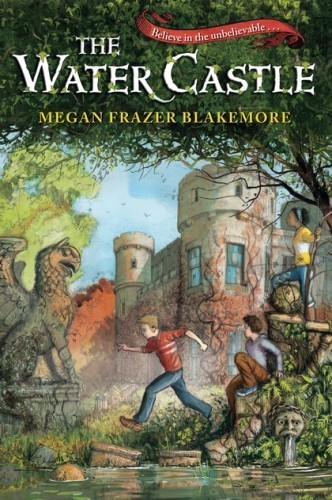 The Water Castle
The Water Castle
By Megan Frazer Blakemore
Illustrated by Jim Kay
Walker Books for Young Readers (an imprint of Bloomsbury)
$16.99
ISBN: 978-0-8027-2839-5
Ages 9-12
On shelves now
Where does fantasy stop and science fiction begin? Is it possible to ever draw a distinct line in the sand between the two? A book with a name like The Water Castle (mistakenly read by my library’s security guard as “White Castle”) could fall on either side of the equation, though castles generally are the stuff of fantastical fare. In this particular case, however, what we have here is a smart little bit of middle grade chapter book science fiction, complete with arson, obsession, genetic mutation, and a house any kid would kill to live in. Smarter than your average bear, this is one book that rewards its curious readers. It’s a pleasure through and through.
Welcome to Crystal Springs, Maine where all the women are strong, all the men are good-looking, and all the children are above average. That last part seems to be true, anyway. When Ephraim Appledore, his two siblings, his mom, and his father (suffering from the after effects of a stroke) move to town he’s shocked to find that not only does everyone seem to know more about his family history than he does, they’re all geniuses to boot. The Appledores have taken over the old Water Castle built by their ancestors and harboring untold secrets. When he’s not exploring it with his siblings Ephraim finds two unlikely friends in fellow outcast Mallory Green and would-be family feuder Will Wylie. Together they discover that the regional obsession with the fountain of youth may have some basis in reality. A reality that the three of them are having trouble facing, for individual reasons.
When one encounters an old dusty castle hiding trapdoors and secret passageways around every corner, that usually means your feet are planted firm in fantasy soil. All the elements are in place with Ephraim akin to Edwin in The Lion, the Witch, and the Wardrobe and a dusty old wardrobe even making a cheeky cameo at one point. What surprised me particularly was the book’s grounding instead in science fiction. That said, how far away from fantasy is science fiction in children’s literature? In both cases the fantastical is toyed with. In this particular case, eternal life finds its basis in discussions of mutant genes, electricity, radiation, and any number of other science-based theories. Interestingly, it’s actually hard to come up with many children’s books that even dwell on the fountain of youth. There’s Tuck Everlasting of course, but that’s about as far as it goes. One gets the impression that Babbitt did such a good job with the idea that no one’s had the guts to take it any farther since. Kudos to Blakemore then for rising to the challenge.
I’m very partial to children’s books that are magical if you want them to be and realistic if that’s what you’d prefer. This year’s Doll Bones by Holly Black, for example, could be an uber-creepy horror story or it could just be a tale of letting your imagination run away with you. Similarly The Water Castle could be about the true ramifications of eternal life, or it could be explained with logic and reason every step of the way. I was also rather interested in how Ms. Blakemore tackled that age-old question of how to allow your child heroes the freedom to come and go as they please without a droplet of parental supervision. In this case her solution (father with a stroke and a mother as his sole caretaker) not only worked effectively but also tied in swimmingly into our hero’s personal motivations.
In the midst of a review like this I sometimes have a bad habit of failing to praise the writing of a book. That would be a particular pity in this case since Ms. Blakemore sucked me in fairly early on. When Ephraim and his family drive into town for the first time we get some beautiful descriptions of the small town itself. “They rolled past the Wylie Five and Dime, which was advertising a sale on gourds, Ouija boards, and pumpkin-pie filling.” She also has a fine ear for antiquated formal speech, though the physical appearances of various characters are not of particular importance to her (example: we don’t learn that Ephraim’s little sister Brynn is blond until page 183).
An interesting aspect of the writing is its tackling of race, racism, and historical figures done wrong by their times. I was happy from the get-go that Ms. Blakemore chose to make her cast a multi-cultural one. Mallory is African-American, one of the few in town, and is constantly being offered subjects like Matthew Henson for class reports because . . . y’know. Henson himself plays nicely into a little subplot in the book. Deftly Ms. Blakemore draws some similarities between his work with Robert Peary and Tesla’s attitude towards Edison. Nothing too direct. Just enough information where kids can connect the dots themselves. For all this, I was a bit disappointed that when we read some flashbacks into the past there doesn’t seem to be ANY racism in sight. We follow the day-to-day activities of an African-American girl and the various rich white people she encounters and yet only ONE mention is made of their different races in a vague reference to the fact that our heroine’s family has never been slaves. This seemed well-intentioned but hugely misleading. Strange to discuss Henson and Peary in one breath and then ignore everyday realities on the other.
If the book has any other problems there is the fact that the author leaves the essential question about the mysterious water everyone searches for in this story just that. Mysterious. There are also some pretty heady clues dropped about Mallory’s own parents that remain unanswered by the tale’s end. Personally, I am of the opinion that Ms. Blakemore did this on purpose for the more intelligent of her child readers. I can already envision children’s bookgroups discussing this title at length, getting into arguments about what exactly it means that Mallory’s mom had that key around her neck.
In the end, The Water Castle is less about the search for eternal life and youth than it is about letting go of childhood and stories. Age can come when you put those things away. As Ephraim ponders late in the game, “No one back in Cambridge would believe that he’d been crawling around in dark tunnels, or climbing up steps with no destination. Maybe, he decided, growing up meant letting go of the stories, letting go in general, letting yourself fall just to see if you could catch yourself. And he had.” Whether or not Ms. Blakemore chooses to continue this book with the further adventures of Ephraim, Mallory and Will, she’s come up with a heckuva smart little creation. Equally pleasing to science fiction and fantasy fans alike, there’s enough meat in this puppy for any smart child reader or bored kid bookgroup. I hope whole droves of them find it on their own. And I hope they enjoy it thoroughly. A book that deserves love.
On shelves now.
Source: Final copy sent from publisher for review.
Like This? Then Try:
Tuck Everlasting by Natalie Babbitt
The House of Dies Drear by Virginia Hamilton
When You Reach Me by Rebecca Stead
Notes on the Cover: Is that or is that not a fantasy cover? The ivy strangled stone gargoyles and castle in the background all hint at it. I wasn’t overly in love with this jacket at first, but in time I’ve discovered that kids are actually quite drawn to it. Whether or not they find it misleading, time will tell. Not having read the bookflap description of this title, I spent an embarrassingly long amount of time trying to turn the kids on the cover into Ephraim and his siblings. It was quite a while before I realized my mistake.
Professional Reviews:
A star from Kirkus
Publishers Weekly
The Wall Street Journal
Jack and Jill
Other Blog Reviews: Cracking the Cover
Interviews: Portland Press Herald
Misc: Check out the Teacher’s Guide for this book.
March 14, 2013
Newbery/Caldecott 2014: The Spring Prediction Edition
Man, isn’t it nice when the award season has died down and we don’t have to deal with any more crazed speculations about who’s “Newbery worthy” or “Caldecott worthy” or any of that nuttiness? We can just sit back and enjoy some books and not . . . not worry about . . . *gulp* . . . ah . . . . grk . . . .
I CANTS TAKES IT NO MORE!!!!
It’s March. Heck, it’s spring. Practically. And so here we have loads of books, TONS of the things, out there and circulating and taking up brain space and all of them just begging to be speculated upon. If it is too early in the season for this, I more than understand. Skip this post. Have some cocoa. Come back in the fall. But if you, like me, just can’t get enough of this stuff, enjoy.
First up, we are visited by the Ghost of Spring Predictions of the Newbery/Caldecott Past. This is always fun. Check it out:
2008 spring predictions: I get one Caldecott right (How I Learned Geography)
2009 spring predictions: I get two Newberys right (The Evolution of Calpurnia Tate and The (Mostly) True Adventures of Homer P Figg)
2010 spring predictions: I get one Newbery right (One Crazy Summer)
2011 spring predictions: I get one Newbery right (Inside Out and Back Again)
2012 spring predictions: I get two Newberys right (The One and Only Ivan and Splendors and Glooms), and one Caldecott right (Green). I’m getting better in my old age! Woot!
We could speculate about what this means about the publishing industry and when they choose to release books, but I’d rather get to the meat of the matter. And I should warn you, I’m finding 2014 to be a VERY strong year in contenders. Newbery anyway.
En garde!
2014 Newbery Predictions
Doll Bones by Holly Black – I am reminded of the year that Silence of the Lambs won an Oscar. That’s the only equivalent I can come up with if this book took home Newbery gold. The writing is superlative, but also creepy as all get out. More so than the relatively recent Newbery winner The Graveyard Book, anyway. But if Gaiman can win . . .
The Water Castle by Megan Frazer Blakemore – It looks for all the world like a fantasy novel when you see the cover, but what you’ll find inside is just the nicest little science fiction novel. I can’t tell if it’s the first in a series or a standalone book that trusts the reader to pick up on certain clever clues. Whatever the case, it’s a brilliant companion to Tuck Everlasting (which, admittedly, never won a Newbery).
Hokey Pokey by Jerry Spinelli – Already one of two thoroughly divisive Newbery contenders. I was enthralled by it but stepping back I’m interested in the child responses. Will the “Ulysses of children’s literature” be too much for them? Is the writing distinguished regardless? Yes to the latter, not sure on the former. At the very least, everyone’s going to have to read this one.
Courage Has No Color, the True Story of the Triple Nickles: America’s First Black Paratroopers by Tonya Lee Stone – She sort of specializes in crushed dreams but in this particular book I think Stone has outdone herself. The sheer subtlety of the writing has to be worth something. Jonathan Hunt brought up a question of whether or not the book sets you up to expect action. I think that’s rather the point.
One Came Home by Amy Timberlake – A book I continually want to call “One Came Back”, for some reason. My brain is weird. If you think Hokey Pokey‘s a divisive topic then you haven’t sat in on some of the Timberlake talks I’ve witnessed. It’s full of life and vitality, and like Gale’s book could also find itself nominated for an Edgar this year. It’s the kind of historical fiction I like to read. The question is whether or not it’ll be the kind of historical fiction the committee likes to read. No clue on that one.
The Center of Everything by Linda Urban – My frontrunner. Maybe. I go back and forth but there’s no denying that Urban gets better and better with each book and that this one is, if you’ll forgive a tired phrase, a gem. Or maybe I was just enthralled by the short page count. Whatever the case, it’s smart and to the point and just lovely from start to finish. ADORE.
2014 Caldecott Predictions
Mr. Tiger Goes Wild by Peter Brown – Ladies and gentlemen of the jury I submit to you the following evidence here and here. Now that the man has won a Caldecott Honor we know that he is capable of even more. There’s a distinct Rousseau-like quality to this book. Peter Brown, like Linda Urban, gets better with each passing book. Remember this one when it comes out in the fall.
The Boy Who Loved Math: The Improbable Life of Paul Erdos by Deborah Heiligman, illustrated by LeUyen Pham – In an era of Common Core Standards and increased attention on nonfiction, why can’t a book on math and a mathematician win the highest Honor in the land? Sometimes I fear that there are certain talented artists that are passed over by the award committees each and every year without fail for no reason other than the fact that they’ve been passed over before. And if anyone deserves a medal it’s Ms. Pham. She’s a delight. So is her art. So is this book.
Stardines Swim High Across the Sky by Jack Prelutsky, illustrated by Carin Berger – Just a second. I’m trying to envision how Mr. Prelutsky would react upon learning that one of his books had won a Caldecott this late in the game. Wouldn’t that be rad (mentioning a poet from my youth apparently causes me to break out the late 1980s jargon)? Berger, for her part, went above and beyond the call of duty when she created the art for this book. Models do NOT fare well in Caldecott races, but certainly an exception can be made once in a while, yes yes?
Unicorn Thinks He’s Pretty Great by Bob Shea – But only if there were any justice in the universe. Which, last time I checked, there is not.
The Dark by Lemony Snicket, illustrated by Jon Klassen – Like Peter Brown, Jon “I just won an Honor and an Award in the same year” Klassen is now considered verifiable Caldecott bait. Admittedly this book is subtler than his previous fare and there’s a lot of black space. I think a forward thinking committee, however, could have a lot of fun parsing where exactly he chose to put one shadow or another. Worthy of discussion, at the very least.
Mr. Wuffles by David Wiesner – I’m just going to imagine for a moment what it would be like to hear lofty librarians parsing the merits of something with a name like “Mr. Wuffles” amongst themselves. It’s a return to form for Wiesner, as weird and wacky and funny as they come. However, he may have handicapped himself by making the book in a comic book style complete with speech balloons. A certain breed of adult reader would have some definite problems with the layouts and action. That said, you have GOT to see this puppy. Nothing else out there is like it.
And that’s the long and short of it. Something for your What To Read Next lists in any case. And as ever, be sure to check out Jonathan Hunt’s 2014 reading list, when you’ve a chance.
CORRECTION: Though I originally included it, it appears that The Bully Book by Eric Kahn Gale may not be eligible. I have learned that it was originally published as an ebook in 2011. Whoops! Sorry about that.


